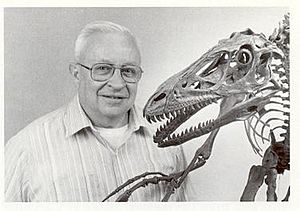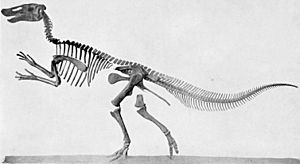John Ostrom facts for kids
Quick facts for kids
John Ostrom
|
|
|---|---|

John Ostrom and Deinonychus skeleton cast. Photo courtesy Yale University.
|
|
| Born | February 18, 1928 |
| Died | July 16, 2005 (aged 77) |
| Nationality | American |
| Alma mater | Yale Columbia Union College |
| Known for | The "Dinosaur renaissance" |
| Awards | Hayden Memorial Geological Award (1986) Romer-Simpson Medal (1994) |
| Scientific career | |
| Fields | Paleontology |
| Doctoral students | Robert T. Bakker Thomas Holtz |
John Harold Ostrom (born February 18, 1928 – died July 16, 2005) was an American paleontologist. He completely changed how we think about dinosaurs in the 1960s.
Ostrom showed that dinosaurs were more like big, non-flying birds than like lizards. He even proved that birds themselves are a type of dinosaur called a theropod. This made scientists wonder if birds should be seen as a kind of reptile.
His work on the ancient bird Archaeopteryx started in 1976. He felt mixed emotions when feathered dinosaurs were finally found in China. This discovery proved many of his ideas right after years of debate.
Contents
Early life and career
John Ostrom was born in New York in 1928. He grew up in Schenectady. At first, he wanted to be a doctor like his father. He studied at Union College.
But a geology class and a book by George Gaylord Simpson changed his mind. He decided to study geology instead. He earned his first degree in 1951. During the 1950s, he learned about ancient animals with backbones. He studied with famous paleontologists at the American Museum of Natural History.
Ostrom went to Columbia University for his advanced degree. He earned his Ph.D. in 1960. His research was about North American hadrosaurs. In 1952, he married Nancy Grace Hartman. They had two daughters, Karen and Alicia.
Ostrom taught at Brooklyn College for a year. Then he joined Beloit College in 1956. In 1961, he became a professor at Yale University. He stayed there for the rest of his career. At Yale, he also became a curator at the Peabody Museum of Natural History.
Throughout his career, Ostrom led many fossil-hunting trips. He went to places like Wyoming and Montana. He also edited a science journal. He wrote many books for both scientists and the public. He received many awards for his work. He retired from Yale in 1992. He kept working on his research until his health declined. John Ostrom passed away in July 2005 at age 77 in Litchfield, Connecticut.
Key discoveries
John Ostrom made several very important discoveries in paleontology.
Hadrosaurs
Ostrom first became known for his studies of hadrosaurs. These were duck-billed dinosaurs. Scientists in the 1960s did not understand their unique noses. Ostrom looked at the noses of modern reptiles. He compared them to hadrosaurs.
He found that hadrosaurs likely had a very good sense of smell. Their nasal passages were long and wound around their skull. Bony crests protected these passages. He thought this strong sense of smell helped them. It could warn them about large meat-eating dinosaurs. Hadrosaurs did not have much armor or speed to protect themselves.
This idea led Ostrom to another conclusion. He thought hadrosaurs lived on dry land, not in swamps. At the time, most scientists thought they lived in wet, watery places. His idea was supported by an old paper he found in 1964. This paper described the stomach contents of a mummified hadrosaur. It had conifer needles, twigs, fruit, and seeds. These are all plants found on land.
Ostrom also studied fossilized footprints of Hadrosaurus. He concluded that these duck-billed dinosaurs traveled in groups, like herds.
Warm-blooded dinosaurs
Ostrom's work on hadrosaurs helped him realize something big. He saw that these large animals stood and moved upright. This would take a lot of energy. Even bigger predators like Tyrannosaurus rex also moved this way.
At a big science meeting in 1969, Ostrom spoke out. He disagreed with the idea that Mesozoic climates were always tropical. He said such warm climates were not needed for large animals. He believed dinosaurs had a high metabolism, like mammals and birds. He noted that modern mammals and birds have upright posture and high body temperatures. He said this connection could not be a coincidence.
In 1973, more evidence supported his view. Hadrosaur fossils were found above the Cretaceous Canadian Arctic Circle. This showed dinosaurs could live in colder places. Ostrom's idea that dinosaurs were warm-blooded was new. But it helped solve many puzzles about how dinosaurs lived. Many scientists soon agreed with him.
Deinonychus
In 1964, Ostrom found more Deinonychus fossils. This is one of the most important fossil finds ever. Deinonychus was an active hunter. It killed its prey by jumping and slashing with its "terrible claw." This is what its name means.
Evidence showed it had a very active lifestyle. Long muscles ran along its tail. This made its tail stiff. It acted like a counterbalance for jumping and running. Ostrom's student, Robert T. Bakker, helped spread the idea. He showed that some dinosaurs had a high metabolism and were warm-blooded. This changed how people saw dinosaurs. They were no longer seen as slow, cold-blooded lizards.
The discovery of Deinonychus changed dinosaur pictures. Artists and the public started seeing dinosaurs differently. This find also started the "dinosaur renaissance." This term was used in 1975 by Bakker. It describes the new interest and debates in paleontology. This "renaissance" has continued since the 1970s. It has led to twice as many known dinosaur types.
Archaeopteryx and the origin of flight
Ostrom became interested in the link between dinosaurs and birds. This started when he studied the Archaeopteryx fossil from Haarlem. This fossil was found in 1855. But it was wrongly called Pterodactylus crassipes. It stayed in a museum in the Netherlands.
In 1970, Ostrom correctly identified it. He said it was one of only eight "first birds" ever found.
Cultural influence
John Ostrom's work showed how dinosaurs moved. He found that their claws and tail muscles meant they ran fast. So, the way we picture two-legged dinosaurs changed. They became seen as agile, fast, and scary hunters. This inspired new dinosaur movies. Museums around the world also changed how they displayed dinosaur bones.
In 1966, John H. Ostrom helped create Dinosaur State Park in Rocky Hill, Connecticut. Children's letters, inspired by Ostrom's work, helped convince the governor to create the park.
Dinosaur dig sites
John Ostrom set up a full-time dig site in the Big Horn Basin, Wyoming, in the 1960s. He also spent a lot of time digging at Rocky Hill.
Scientific classification
- In 1970, John Ostrom officially named Microvenator celer. Its name means "fast small hunter."
- Also in 1970, he named Tenontosaurus tilletti. Its name means "tendon lizard."
- In 1993, scientists James Kirkland, Robert Gaston, and Donald Burge named a fossil Utahraptor ostrommaysorum. They named it after John Ostrom and Chris Mays. The largest found example of this dinosaur was 23 feet long. It weighed over 1000 pounds.
- In 1998, Catherine Forster named a fossil Rahonavis ostromi. Its name means "Ostrom's menace from the clouds." She named it to honor John Ostrom. This fossil was a primitive winged creature. It had a two-foot wingspan and feathers. It also had a sickle-shaped claw on its second toe. This claw was for slashing prey, like Deinonychus and Archaeopteryx.
- In 2017, a new genus called Ostromia was named in his honor. This name was given to the Haarlem specimen, which was once thought to be Archaeopteryx.
Images for kids
See also
 In Spanish: John Ostrom para niños
In Spanish: John Ostrom para niños



